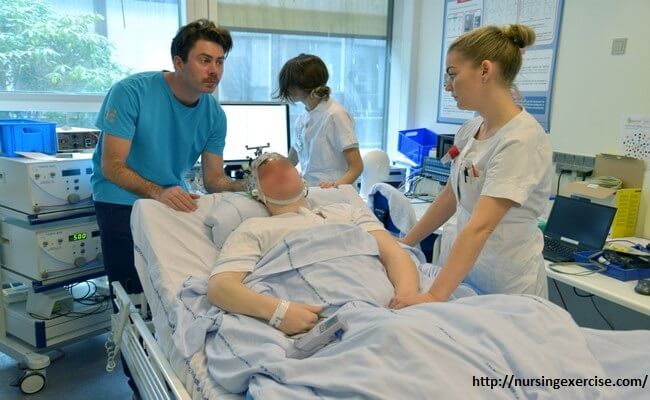What is Head Injury?
A head injury is any sort of injury to the brain, skull, or scalp. Head injury ranges from a mild bump or bruises up to a traumatic brain injury. There are some common injuries of a head injury patient including concussions, skull fractures, and scalp wounds. The nursing care plan of all types of head injury patients has discussed in this article.

Nursing Care Plan for Head Injury Patient:
All the nursing interventions of head injury have presented in the following:
- Assess neurologic and respiratory status to monitor for the sign of increased ICP (Increased intracranial pressure) and respiratory distress.
- Have to monitor and record major symptoms and intake and output, increased intracranial pressure, hemodynamic variables, cerebral perfusion pressure, specific gravity, laboratory studies, and pulse oximetry to detect early signs of compromise.
- Observe for the sign of increasing increased intracranial pressure (ICP) to avoid treatment delay and prevent neurologic compromise.
- Assess for CSF leak as evidenced by otorrhea or rhinorrhea. Cerebrospinal fluid (CSF) leak could leave the patient at risk for infection.
- Assess for pain. Pain may cause anxiety and increase increased intracranial pressure (ICP).
- Check a cough and gag reflex to prevent aspiration.
- Have to check for different symptoms of diabetes insipidus (High urine output, low urine specific gravity) to maintain hydration.
- Administer I.V fluids to maintain hydration.
- Administer oxygen to maintain position and patency of endotracheal tube if present, to maintain the airway and hyperventilate the patient, and to lower increased intracranial pressure (ICP).
- Provide suctioning; if the patient is able, assist with turning, coughing, and deep breathing to prevent pooling of secretions.
- Maintain position, patency, and low suction of NGT to prevent vomiting.
- Maintain seizure precautions to maintain patient safety.
- Administer medication as a prescription to decrease increased intracranial pressure (ICP) and pain.
- Allow a rest period between nursing activities to avoid the increase in increased intracranial pressure (ICP).
- Encourage the patient to express feeling about changes in body image to allay anxiety.
- Provide appropriate sensory input and stimuli with frequent reorientation to foster awareness of the environment.
- Provide means of communication, such as a communication board to prevent anxiety.
- To prevent tissue damage, provide eye, skin, and mouth care.
- Turn the patient every 2 hours or maintain in a rotating bed if condition allows preventing skin breakdown.
More questions related to this article:
- What do you understand by a head injury?
- What is a head trauma?
- What is meant by a head injury patient?
- Explain the nursing management of head injury patients.
- How will you manage a case of traumatic injury or head injury?
- Point some nursing interventions of head injury.
- What is the first aid treatment for a head injury?
- What is the treatment for head injuries?
- Describe the nursing care plan for a head injury patient.
- What are the nursing care plans for head trauma patients?
- What are the nursing interventions for critically ill traumatic brain injury patients?
- Describe nursing as a patient with a severe head injury in a case study.

Maria Khatun Mona is a Founder and Editor of Nursing Exercise Blog. She is a Nursing and Midwifery Expert. Currently she is working as a “Senior Staff Nurse” at “Dinajpur Medical College Hospital”, Bangladesh. She has great passion in writing different articles on Nursing and Midwifery. Mail her at “maria.mona023@gmail.com”

I’ve just discovered this website. As a nursing student reviewing/refreshing material, these articles are really helpful! To the point, clear, while still in depth with the relevant/important information. Great for note taking!! thank you
Stay with us for more.